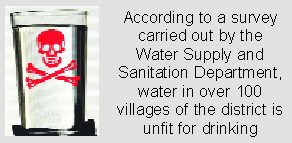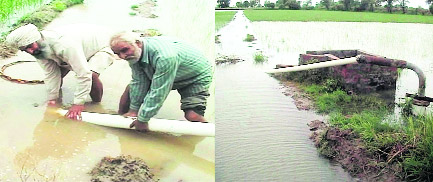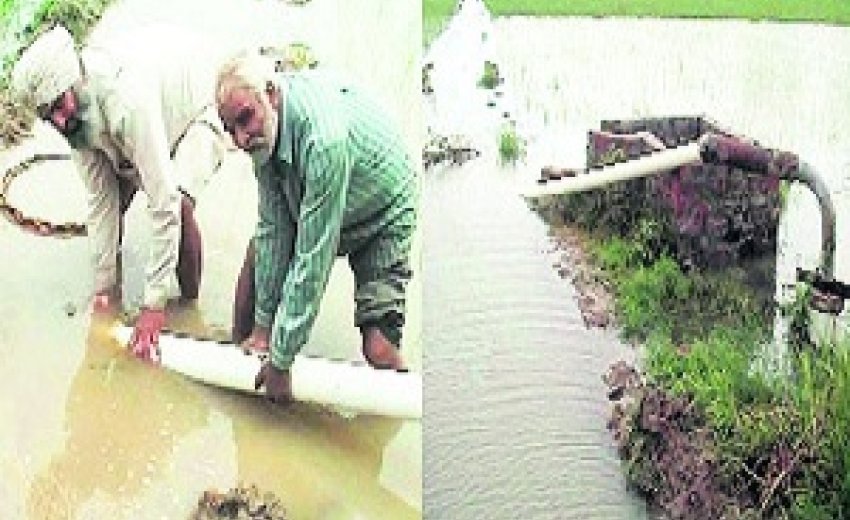Let's start with some scary stats on ground water in Punjab care of The Tribune:
* In the dark zones, pumps have gone down to a depth of 450 feet.
* Rain water can recharge groundwater only up to 80-90 feet. So, the pumps extracting water from a depth of 300-400 feet are drawing water from reserves that are irreplaceable.
* Nihal Singh Wala subdivision in Moga district is worst affected at an exploitation rate of 400 per cent.
* Number of tubewells have increased from 1.2 lakh in 1970s to 13 lakh in 2010.
* Groundwater decline has reached 50 to 100 cm per annum.
* During 1993 to 2003, the average fall in water table was 2 feet per year.
* Out of 70 blocks in the water table, in 40 blocks have gone down below 50 feet.
* The worst affected districts are Sangrur and Moga where the water table is below 50 feet.
To top it off, ground water has been found to be undrinkable in over 100 Punjabi villages:
 Patiala, July 24: Potable water has become the primary concern in villages throughout this district. According to a survey carried out by the Water Supply and Sanitation Department, water in over 100 villages of the district is unfit for drinking. This survey was carried out almost an year ago. The report was submitted around two months back that read that the water has a very high content of fluoride which makes the water unfit for drinking.
Patiala, July 24: Potable water has become the primary concern in villages throughout this district. According to a survey carried out by the Water Supply and Sanitation Department, water in over 100 villages of the district is unfit for drinking. This survey was carried out almost an year ago. The report was submitted around two months back that read that the water has a very high content of fluoride which makes the water unfit for drinking.
This survey was also conducted in Ludhiana, Taran Tarn, Ferozepore and Faridkot but Patiala villages were found to be the worst hit.
Fluoride, which leads to various diseases related to bones, have long-time effect on people. It leads to deformation of bones. It has been found out that the fluoride has infiltrated to the depth of 60 feet. Therefore the department has come up with a new scheme ‘Nirmal Jal’ which will enable people to get potable water.
The tubewells would be further dug as the water at around 90 feet has lesser fluoride.
The older schemes will be renewed and in villages where such schemes haven’t reached, this would be started with an investment of around Rs 30 lakh. Sources said the World Bank and the department had joined hands for the fulfillment of this scheme and it would be completed by 2011.
 |
| An interesting technique that farmers have developed to recharge groundwater |
Over-exploitation of ground water to meet irrigation needs has in recent years created a big problem of water shortage in Punjab. Unfortunately, rain water harvesting and recharging of ground water, which are the need of the hour, are virtually not in use in the state. But, some farmers of Ghal Kalan village in Moga district have developed an innovating technique to pull out extra water from the waterlogged fields through electric tubewells without consuming power. They do this with the help of natural gravitational force and atmospheric pressure.
The technique is very simple. The farmers attach a 10-12 metre pipe with the main pipe of the tubewell and put in the water-logged paddy field by digging a small pit under it. Then by holding it in the water, the electric motor is switched on and as soon as water starts coming out of the pipe the motor is switched off. The water gushing out of the pipe stops and the atmospheric pressure forces the outside water into the pipe in a sudden reverse action and then the gravitational force keeps the system working in continuity sending the water under the ground through the bore well pipe.
The water starts going down the ground at almost an equal speed by which it comes out. When the system starts working, the farmers place a basket made of wooden twigs under the pipe dipped in the flood water from where it gushes into the pipe.
Another farmer Guljar Singh said he had saved his paddy crop that got completely submerged with the help of this technique within two days. “Water level in my fields has now come down from four feet to half feet without any damage to the crop”, he said.
Board finds high arsenic level in water samples, reports Sarbjit Dhaliwal, Tribune News Service @ www.tribuneindia.com/2010/20100728/punjab.htm#1
Jalandhar, July 27: The Central Ground Water Board has found the presence of arsenic matter beyond the permissible limit in water samples drawn randomly from some hand pumps in certain villages in the state.
The board, which tested the samples at its lab in Chandigarh, has confirmed the presence of arsenic matter in its report that is to be submitted to the Union Government soon.
The level of arsenic matter in the water is so high that people need to be be told to stop drawing water from these hand pumps. “Such pumps should be sealed immediately,” said an official of the board. The permissible limit of arsenic in drinking water is 0.01 mg per litre. However, at a hand pump installed at a bus stand at Bhamme Kalan, near Mansa, the arsenic level in the water drawn from that pump was found to be 0.2080 mg per litre, which is very high. “ No one should drink water from that pump,” said the official.
The arsenic level in the water of a submersible pump owned by Roop Ram at Dhaipi, near Cheema Mandi (Sangrur), was found to be 0.207 mg per litre, beyond permissible limit.
“As an alarming level of arsenic matter has been found in some shallow hand pumps, we will go in for an extensive study in this regard in the entire state,” said a board official. The reckless use of pesticides seems to be the reason for such a high level of arsenic matter in shallow hand pumps.
On instructions from Union Water Resources Minister Pawan Bansal, a team of scientists of the board had collected 105 samples of water drawn from hand pumps, tubewells and submersible pumps.
Ram Pal Dhaipi, general secretary of the Punjab unit of the Congress, had approached Bansal for getting the water samples tested. Dhaipi has been active in the Malwa belt, taking up the cause of people suffering from cancer.
The level of arsenic matter in water drawn from a hand pump owned by a farmer, Harmesh Singh, at Meerpur Dhani, near Sardulgarh, has been found to be 0.0163 mg. At Ghari Bhaggi, the level in water from a hand pump owned by Sukhdev Singh, a panch, has been found to be 0.147 mg per litre. Likewise, the level of arsenic matter in water from hand pumps at Nandgarh and Kotra Kalan have also been found the beyond permissible limit.
